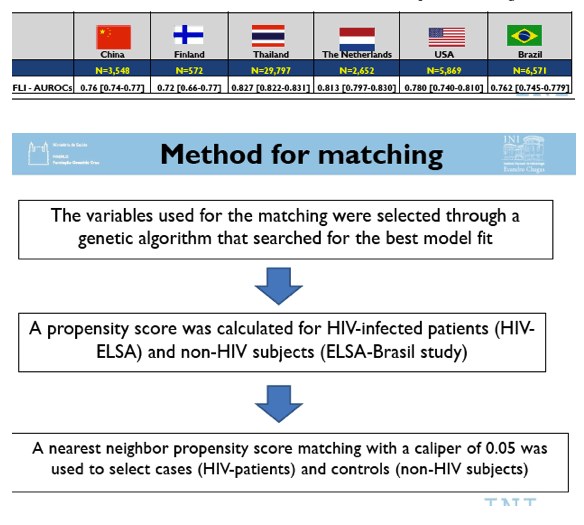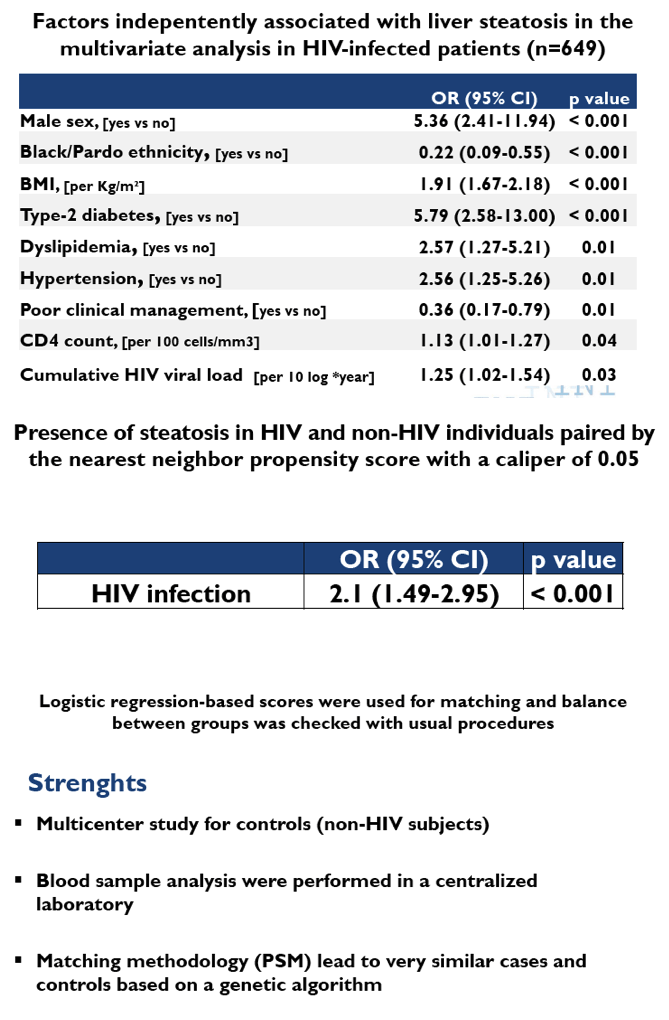 |
 |
 |
| |
Two-fold higher chance of liver steatosis with HIV in big Brazilian study
|
| |
| |
22nd International AIDS Conference, Amsterdam, Netherlands, July 23-27, 2018
Mark Mascolini
Compared with matched HIV-negative controls, HIV-monoinfected people in a large Brazilian analysis had a 2-fold higher risk of liver steatosis [1]. The study also linked higher body mass index, diabetes, abnormal lipids, hypertension, and other variables to steatosis.
Researchers from Rio's Oswaldo Cruz Foundation and collaborators at other centers noted that obesity, type 2 diabetes, dyslipidemia, a sedentary lifestyle, and genetics may contribute to the evolution of simple steatosis to nonalcoholic steatohepatitis (NASH) and then to cirrhosis. Steatosis prevalence in people with HIV is high in studies across Europe, the Americas, and China, but the association of HIV with steatosis remains uncertain.
To address these issues, the Oswaldo Cruz investigators assessed steatosis prevalence and risk factors in HIV-monoinfected individuals and compared that group with HIV-negative people paired for confounding factors. The 649 people with HIV came from a prospective Rio cohort, while the 15,105 HIV-negative people came from a 6-center longitudinal Brazilian study.
The researchers defined liver steatosis as a fatty liver index at or above 60. They selected matching variables through a genetic algorithm that searched for the best model fit and then calculated a propensity score for people with and without HIV. Among 649 people with HIV, the investigators used logistic regression to pinpoint factors associated with liver steatosis. The matching analysis involved 333 people with HIV and 333 without HIV.
The overall HIV group was younger than the overall HIV-negative group (median 44 versus 51 years) and included a lower proportion of women (42% versus 54%) and a lower proportion of black/Pardo people (23% versus 44.2%) (P < 0.001 for all differences). Among 649 people with HIV, 9 factors independently predicted liver steatosis: male gender (adjusted odds ratio [aOR] 5.36, P < 0.001), black/Pardo ethnicity (aOR 0.22, P < 0.001), higher body mass index (aOR 1.91 per kg/m2, P < 0.001), diabetes (OR 5.79, P < 0.001), abnormal lipids (aOR 2.57, P = 0.01), hypertension (aOR 2.56, P = 0.01), poor clinical management (aOR 0.36, P = 0.01), higher CD4 count (aOR 1.13 per 100 cells, P = 0.04), and higher cumulative viral load (aOR 1.25 per 10-fold*year higher, P = 0.03).
The HIV+/HIV- matching analysis linked HIV infection to twice higher odds of steatosis (OR 2.1, 95% confidence interval 1.49 to 2.95, P < 0.001).
The researchers noted that their analysis is limited by lack of liver biopsy or imaging to establish liver steatosis. But they believe the matching methodology led to very similar cases and controls and thus to a reliable estimate of steatosis risk with HIV.
Reference
1. Pacheco A, Perazzo H, Cardoso S, et al. HIV infection is an independent risk factor for liver steatosis: a study in HIV mono-infected patients compared to uninfected paired controls and associated risk factors. AIDS 2018: 22nd International AIDS Conference, Amsterdam, Netherlands, July 23-27, 2018. Abstract THAB0205.
EACS: Non-viral Liver Disease Burden in HIV Mono-infected Individuals: A Prospective Cohort Study - (12/07/17)
Fatty Liver in HIV - (07/18/17)
NATAP Fatty Liver Section http://www.natap.org/liver.htm
IAS/2017: Predictor factors associated with liver fibrosis and steatosis by transient elastography in HIV mono-infected patients under long-term combined antiretroviral therapy - (07/26/17)
Fatty Liver, NASH in HIV - (01/30/18).....from same study author Perazzo - this study reported duration cART is associated with fatty liver (steatosis), and so are central obesity, dyslipidemia and diabetes, and history of AZT use, and duration of having HIV.








|
| |
|
 |
 |
|
|